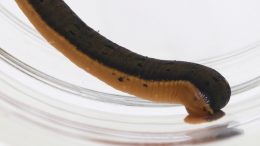Could a five-inch-long, bloodsucking leech inspire efforts to protect other leech species?
Yes, according to researchers — but only if it’s not already extinct.
That’s a possibility, as the New England medicinal leech (Macrobdella sestertia) — a name that dates to the practice of using leeches to “treat” fevers and other health conditions — hasn’t been observed in the wild since 2008.
 But it’s gone long unseen several times before. The species, a relative of the much more common American medicinal leech (M. decora), was first described back in 1886, after which no reports of its existence emerged again until 1977. It had been presumed extinct before that rediscovery.
But it’s gone long unseen several times before. The species, a relative of the much more common American medicinal leech (M. decora), was first described back in 1886, after which no reports of its existence emerged again until 1977. It had been presumed extinct before that rediscovery.
Since then it’s remained a bit of an enigma. Just a handful of reports of its existence have emerged from the leech’s wetland habitats in Massachusetts, Maine and New Hampshire.
We don’t know exactly why it’s been so hard to find — it may always have been rare — but the Massachusetts Division of Fisheries and Wildlife describes it as “likely sensitive to shoreline changes and declines in water quality” and identifies sewage seeps and habitat loss as potential threats.
And maybe we weren’t looking in the right places. Recent research revealed that several New England medicinal leeches were observed in 2002 and 2008 in South Carolina — far outside their previously recognized range. The discovery wasn’t published until 2018.
Another recent finding provides even more hope. Last year scientists at the Smithsonian’s National Museum of National History announced that they’d identified a new Macrobdella species, the first such discovery in 40 years.
For #NationalRelaxationDay we share this hypnotic video…of a LEECH. Its name is Macrobdella mimicus. And it was just described today in the Journal of Parasitology, by our curator of parasitic worms, Anna Phillips @Annalida500, and a team of scientists. pic.twitter.com/3iCQO9h2Uk
— Smithsonian’s NMNH (@NMNH) August 15, 2019
They found it just 50 miles from the museum, as well as in museum collections around the country, where it had been misidentified as other species.
“A discovery like this makes clear just how much diversity is out there remaining to be discovered and documented, even right under scientists’ noses,” said lead researcher Anna Phillips, the museum’s curator of parasitic worms, at the time.
That theme echoes in the new paper about the New England medicinal leech by Phillips and Georgetown University biologist Colin Carson. They’re calling for additional surveys to find any remaining populations of the lost species, as well as assessing it to be listed under the Endangered Species Act and the IUCN Red List. They also recommend protecting critical freshwater habitats and creating Red List entries for it and at least a dozen other rare or vulnerable leeches.
If protected or rediscovered, Phillips and Carson suggest that the New England medicinal leech could serve as “the first flagship species for parasite conservation.” As they write in their paper:
“…parasitic leeches are a comparatively easy ‘sell’ for parasite conservation: they are diverse, useful in medicine and as a model organism in developmental biology, striking and often colorful in appearance, have an infamous reputation, and are unlikely to pose a major threat to endangered hosts.”
Of course, the question remains: Does the New England medicinal leech still exist or is it extinct? Phillips and Carson devote the core of their paper to that problem. They used a series of six “extinction date estimator” mathematical models to calculate the probability of the species continued existence based on how often and when it was last observed. Their conclusion: There’s just not enough evidence to support the hypothesis that it’s no longer with us.
That’s potentially good news for now, but it doesn’t mean this species is exactly safe. Two of the six models suggest it might already be extinct, while a third calculates the year it could go extinct as…2020. The other three models give it a little bit more time — anywhere from 2027 to 2046.
As Phillips and Carson note in their paper, only a handful of leech species have ever received conservation protections. Could the New England medicinal leech help turn that trend around? It’s certainly time to try — while there’s still time to try.
![]()
Previously in The Revelator:
Why We Should Care About Parasites — and Their Extinction


